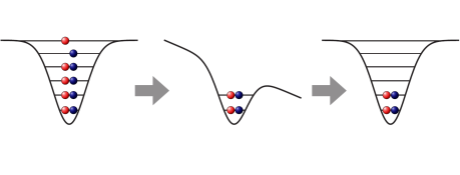Heidelberg Physicists Create Ultracold Designer Atom
15 April 2011

In experiments with ultracold lithium atoms, physicists from Heidelberg have succeeded in preparing a tunable few-body system in a reproducible way. This “designer atom” can help to enhance our understanding of fundamental few-body systems in nature because of its high degree of tunability, including both the number of constituents and their interparticle interaction. The experiments were conducted by scientists from Heidelberg University and the Max-Planck-Institut für Kernphysik headed by Prof. Dr. Selim Jochim (Institute of Physics). The research results have now been published in Science.
Systems consisting of a small, well-defined number of particles are the building blocks of matter. Examples are atomic nuclei which are made up of protons and neutrons or atoms with a nucleus and a specific number of electrons. The properties of atoms and nuclei are uniquely defined by nature, thus in principle measurements of such systems are perfectly reproducible. One example is the atomic clock, which relies on this reproducibility to measure time with extreme precision.
“This reproducibility comes at the cost of limited tunability,” says Professor Jochim. “The properties of these systems can hardly be changed at all. This is why various approaches are pursued to create synthetic few-body systems with tunable properties. Examples include quantum dots and atomic clusters.” Such systems are much more susceptible to manipulation than genuine atoms or nuclei, but achieving control over all the quantum mechanical degrees of freedom in the system is a formidable challenge because these systems are strongly coupled to their environment.
Scientists at Heidelberg University have now mastered this challenge and achieved the reproducible preparation of such an artificial atom in a precisely defined quantum state. In their experimental setup, the role of electrons in an atom is taken by ultracold, fermionic lithium atoms caught in a trap measuring only a few micrometres. “To realize this trap we use a strongly focused laser beam in which the atoms are confined to the intensity maximum. The trap is filled from a reservoir of lithium atoms with a temperature of less than a millionth of a degree above absolute zero. According to Pauli’s exclusion principle, each quantum state in this small potential is occupied by only one atom, in analogy to the electrons in an atom,” says Friedhelm Serwane, doctoral candidate in Prof. Jochim’s research group and leading author of the Science article.
The number of particles is controlled by superimposing a spatially varying magnetic field on the trap created by the laser beam. The lithium atoms possess a magnetic moment and are thus subjected to a force tilting the trap. The extent of the tilting determines the number of remaining atoms. One example for the extreme tunability of the new system is that the interaction between the particles can be modified at will. This corresponds to varying the electron charge in a genuine atom. With their high reproducibility and tunability, the Heidelberg experiments open the door for the simulation of a large number of quantum systems. This brings physicists one step closer to the far-sighted ideas of physics Nobel Prize laureate Richard Feynman, who in 1982 dreamed of a universal quantum simulator which would be able to experimentally simulate any given quantum system.
In the months prior to this success, the experiments of Prof. Jochim’s research group had already produced outstanding results. One of these was the first direct evidence of so-called Efimov trimers that physicists had been trying to track down for decades. This result was also published in Science. “The excellent research environment in Heidelberg contributed significantly to my team’s quick success,” says Professor Jochim, “notably the Heidelberg Center for Quantum Dynamics established in the framework of the Initiative for Excellence, the Max-Planck-Institut für Kernphysik and the ExtreMe Matter Institute (EMMI) of the nearby GSI Helmholtzzentrum für Schwerionenforschung in Darmstadt.”
For more information, go to www.lithium6.de
Note for news desks
Digital picture material is available from the Press Office (see below).
Original publication
F. Serwane, G. Zürn, T. Lompe, T.B. Otterstein, A.N. Wenz, S. Jochim: Deterministic preparation of a tunable few-fermion system. Science, Vol. 332, 15 April 2011, 6027, doi:10.1126/science.1201351
Contact
Prof. Dr. Selim Jochim
Institute of Physics
phone: +49 6221 516229
jochim@uni-heidelberg.de
Communications and Marketing
Press Office
phone: +49 6221 542311
presse@rektorat.uni-heidelberg.de

